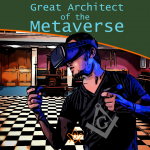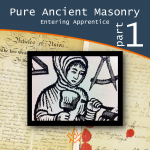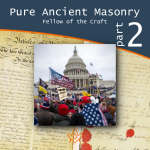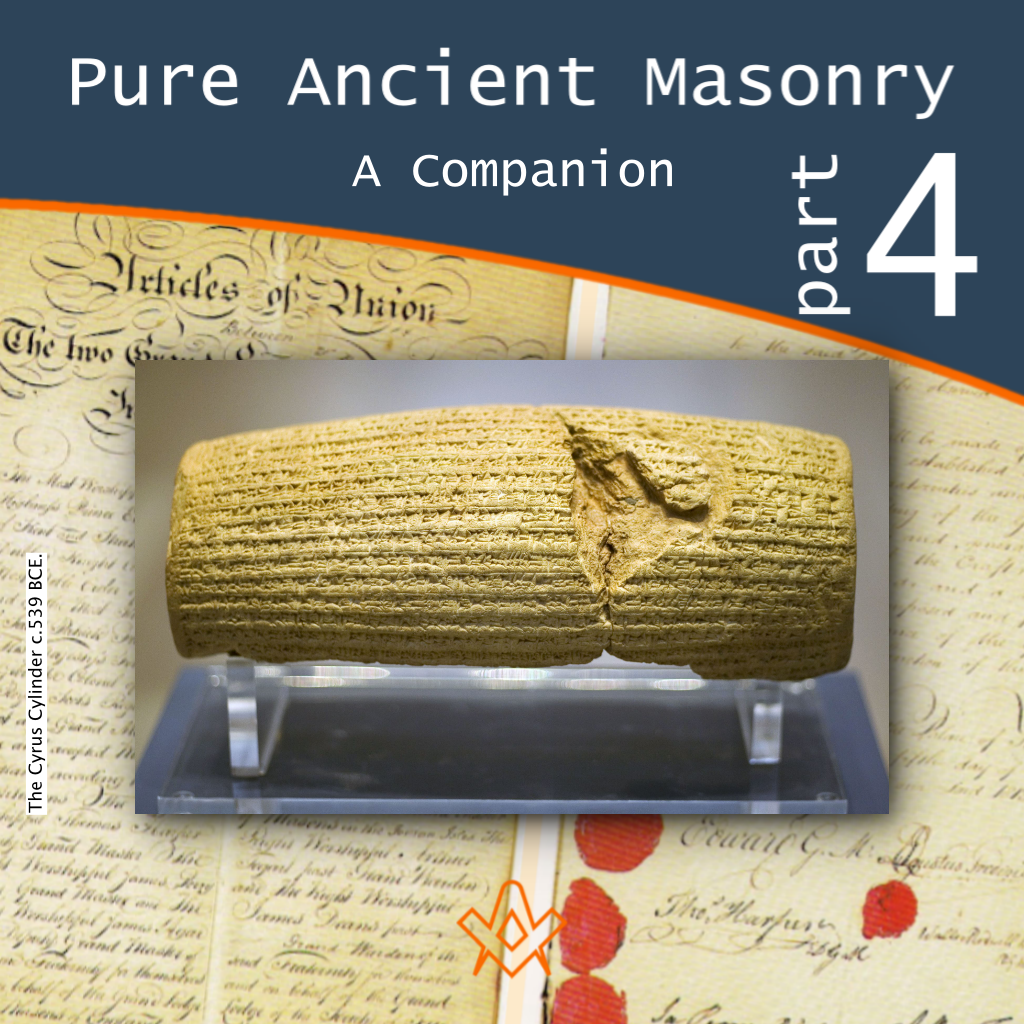‘A body without a soul?’
Pure Ancient Masonry consists of Three Degrees and no more, including the Order of the Royal Arch

Introduction: A new thought-provoking series on ‘conjoined’ Masonry and ‘the soul of the body Masonic’.
Part 1: An Entering Apprentice, Building Better Communities.
· Contractually entering an order to learn and serve.
· Learning from the Master: technical craftsmanship, ethical workmanship, and interdependence.
· Learning through a guild: charitability, state craftsmanship and engaging with the community.
Part 2: Fellow of the Craft, Building Better Knowledge
· Now with citizenship and trading rights to serve and work.
· Acquiring knowledge of ‘nature’ and ‘science’; a scientific citizen of the world.
· Knowledgeable engagement with the community and beyond.
Part 3: The Master, Building Better Character
· Progressing from craftsman to architect.
· Progressing from knowledge to wisdom.
· Preparing for leadership and management in government, trade, and civil society.
Part 4: A Companion in Rule, Building a Better World.
· Pan-jurisdictional vision.
· Pan-jurisdictional service.
· Enhancing the lessons of Parts 1 – 3 as a Citizen of the World.
These are the building blocks of the body Masonic, wherein its soul abides.
‘When we build, let us assume we are building forever.’
– John Ruskin

To be of any earthly use, freemasonries must engage with the world as it is becoming; not, as receding.
To promote migration from analogue to digital Freemasonry – including a temporary conjoining of physical and virtual experience – the series will include something of the implications of ‘Metaverse’ as excellently introduced by The Square Publisher, Nicholas Broadway.
‘It is the ability to do anything imaginable, albeit in a virtual world.’ (The Gospel according to Mark [Zuckerberg]).
In so doing, it will assume that the old and new will coexist until the former withers. See Broadway’s Product Life Cycle of Freemasonry – Square Magazine
For freemasonries to survive, their digitisation is necessary:
‘…without the means of change is without the means of…conservation.’
(After Edmund Burke, Reflections on the Revolution in France.)
This four-part series has sought to identify the defining characteristics, lessons, and benefits, of each of the Three Degrees and the Order of the Royal Arch (no longer ‘Holy’) which when combined, comprise Pure Ancient Masonry.
Semantics aside – degrees/orders/steps – Pure Antient Masonry consists of four parts.
These must be understood as four aspects of a seamless whole: why not confer each part in lodge opened in four stages?
Arrangements for progressing from the third part to the fourth should be no more involved than those from first to second or second to third.
Yes, this series is proposing the Three Degrees and the Royal Arch as a practical, unifying, unified theory – a seamless whole – a preparation for world citizenship as announced in the First Degree and realised in the Royal Arch.
Pure Ancient Masonry is to be understood as a fraternal order predicated on being an enhanced form of citizenship: we are what we do.
The contemporary Post Truth milieu claims that most of what is said and done is driven by feelings: such are outside of a truth or falsehood analysis.
Freemasons should not believe anything they are told; but not disbelieve it either!
We must cultivate respect for, and be comfortable with, ‘I do not know’ – agnostic.
Wise decision-making to be based on: ‘What would a good citizen do?’ If enhanced citizenship is not part of a Freemasonry, something essential is missing.
Part 4; A Companion in Rule, Building a Better World

Cyrus 38 (UGLE) Royal Arch Chapter Lodge Room
IMAGE CREDIT: The Square Magazine – publisher’s collection
Surveys indicate that Royal Arch membership is maintained by the convincing and engaging narrative of the sojourners; indeed, to act as if one believes a particular story is quintessentially human.
The main objection to the Royal Arch is that ‘it is too religious’. It is unlikely that 21st Century, freemasonries will be sustained by people joining it to enhance their supernatural religious beliefs.
Some wishing to discover freemasonries may be told that they are without identifiable ideology. Yet they identify with humanistic values! The four-part offer of Pure Antient Masonry being preparation for enhanced citizenship has yet to be made.
The Royal Arch is an exposition of the Cyrus narrative as included among Rabbinical writings and in the Old Testament. However, it was somewhat interpreted and applied for the purposes of constructing a narrative of Jewish nationhood.
Much has been written on the Cyrus ‘proclamation’; Part 4 is presenting this phenomenon as a pan-national model of governance and citizenship.

Assyrian tablet with cuneiform script.
IMAGE LINKED: wikimedia Attribution 4.0 International (CC BY 4.0)
Cuneiform (c. 3000 BCE) is perhaps the first form of written language.
It is believed to have been started between Mesopotamian tax-collectors and farmers tracking their herds and counting harvests. It was produced by making indentations into mud/clay tablets with two then five elemental reeds, formed as either wedges or rectangles.
To these were added pictures, signs, concept words and finally sounds and parts of speech.
Children perhaps played and created games with reeds in mud/clay; this play developed the system and formed the practice of the next generation.
Perhaps this process has been on-going and now known as social media. Our brains make our mind by virtue of their ever-ramifying expression of cultural possibilities.
This, not by specific changes but, in the process of change itself. Not on scrolls of velum or parchment however but after being produced on clay tablets/cylinders, cuneiform became impressed on papyrus.
Cuneiform cylinders may have been a mode for applying an authoritative signature.
Thus, by the time of Cyrus, the Cylinder may have become ‘impressed’ authority: from farms to all the kingdoms of the world.

The Cyrus Cylinder c.539 BCE.
IMAGE LINKED: wikimedia Attribution 4.0 International (CC BY 4.0)
In 1879, the Cyrus Cylinder, one of the great archaeological finds of the Century, was unearthed in what is now modern Iraq.
Formed of clay, impressed in cuneiform, it is an account of the Cyrus conquest of the Babylonian Empire and beyond. It proposes the basis for his Persian Imperial rule from the perspective of a sycophantic spin doctor, hyperbole at its highest!
Perhaps there is no such thing as translation, only interpretation. Most likely for centuries, ‘documents’ pertaining to the area would have been written in Phoenician Aramaic – the language of trade.
This author’s understanding of the Cyrus Cylinder narrative is based available online interpretations; from these, it is inferred that Cyrus, and/or those around him, had a remarkable insight into a viable governance.

Statue of Marduk depicted on a 9BC cylinder seal. Via Wikipedia By Franz Heinrich Weißbach – Franz Heinrich Weißbach (1903), Babylonischen Miscellen. Wissen-schaftliche Veröffentlichungen der Deutschen Orient-Gesellschaft 4, p. 16., Public Domain
IMAGE LINKED: wikimedia Attribution 4.0 International (CC BY 4.0)
The Cyrus narrative describes the ‘King’ of Babylonia seeking to replace Marduk, the incumbent deity, the ‘great lord and guardian of his people’.
Unamused, Marduk sought a righteous king to be installed in Babylon: the lot fell on Cyrus, ‘Whom, Marduk set on the road and accompanied him as a companion and friend’.
Also, an innumerable, armed, army marched at his side. Interpretations of the Cylinder narrative indicate that on arriving at Babylon, the rulership of Cyrus was unopposed; this supporting a claim that all the kingdoms of the four corners of the earth had been ‘given’ to him by deity, an unequivocal claim to the divine right of kingship.

The Persian Empire – Cyrus The Great 559-530
IMAGE LINKED: wikimedia Attribution 4.0 International (CC BY 4.0)
Perhaps the claim ‘all the kingdoms of the four corners of the earth’ is exaggerated: the Persian Empire of Cyrus the Great did not include Egypt and other ‘kingdoms’ known to Phoenician traders.
Yet, it is acknowledged as being the largest empire to date. The military defeat of a country is one thing, maintaining control over it is another.
Possibly, implicit in the Cyrus Proclamation is all peoples’ seen as one ‘family’ and that rulership entailed a ‘guardianship / stewardship’ role.
People were subjects rather than slaves with perhaps a hint of citizenship: ‘enlightened despotism’?
Perhaps the genius of the Cyrus administration included a realisation that coercive centralisation would, on-going and at best, be a resource-intensive policy.
And, that devolution to provinces with grand masters (satraps) could be effective, efficient, and enforceable with central control remaining over agricultural production and the military.
The point is local rulers were appointed by the centre to which they were accountable. Zerubbabel, Haggai, Joshua, Ezra, and Nehemiah; were officials in Judah, working with and for the Persian authorities.
Prior connections with royalty, priestly office, and the ability to write might have favoured their selection.
Seemingly, devolution included ‘religious freedom’ but again, the implications of this can be exaggerated; the first loyalty was to Cyrus, the people were subjects/citizens of his Empire: Judah had passed from Babylonian to Persian hegemony.
And of course, each province paid its ‘subscriptions’ to the centre. Perhaps not insignificantly, the Second Charge of a Freemason, dealing with citizenship, is titled Of the CIVIL MAGISTRATES, supreme and subordinate: Empire and Province?
Seemingly, Cyrus did not need to eradicate the ‘national’ identity of the conquered lands; however, what might have been the extent of assimilation?

The four-winged guardian figure representing Cyrus the Great or a four-winged Cherub tutelary deity. Bas-relief found on a doorway pillar at Pasargadae on top of which was once inscribed in three languages the sentence “I am Cyrus the king, an Achaemenian”
IMAGE LINKED: wikimedia Attribution 4.0 International (CC BY 4.0)
And for the avoidance of doubt, as interpreted from the Cylinder, the claim, ‘I am Cyrus, king of the world, great king, mighty king, king of Babylon, king of Sumer and Akkad, king of the four quarters’ was hardly the basis for a human rights charter.
Neither exiles from Jerusalem, nor the prophet Jeremiah, nor an exile of seventy years are mentioned in interpretations of the Cyrus Cylinder.
It is unlikely that many taken into Babylonish captivity would have been alive seventy years later and if so, unlikely to have been fit to make a six-hundred-mile journey to Jerusalem.
If religious freedom was now available throughout the Empire, why would first and second generation ‘exiles’ wish to make such a journey? Some didn’t, preferring the fleshpots of Babylonia.
Interpretations of the Cylinder allude to rebuilding the walls of Babylon, rebuilding destroyed dwellings and setting kings in palaces.
The policy of de-centralisation would require provincial administrative centres and buildings: that temples, anywhere, were restricted to ‘religious service’ is unlikely.
The Cyrus administration realised that civil servants and soldiers needed supplies; subsistence was needed for those who produced food, clothing, shelter, material, and items for export.
This may well have led to a range of infrastructural construction projects throughout the Empire.
Exiles returning from Babylon may well have been encouraged / expected / conscripted to assist with these undertakings.
Interpretations of the Cylinder refer to the deity Marduk as the ‘guardian of his people’.
Was it the case that the Cyrus administration understood an interdependence between rulers and ruled in some form of ‘social contract’? Much of the Western ‘liberal democracy’, of the last three-hundred-years, has been underpinned by social contract theories.
Such, comprise an offer made by a nation state to protect citizens from threats, from within and without (peace to the whole earth), in exchange for loyalty and taxation.
Social contract theories can be understood as narratives. The criminal activity known as a ‘protection racket’ is where a powerful group advises organisations and/or individuals of threats; and in return for payment, offers protection therefrom.
It is for nation states to demonstrate that they are promoting more than nationalised protection rackets. The unhelpful dichotomy, Nationalism – Liberalism, must be replaced with a recognition of, and uniting around, an informed worldview; thinking globally followed by acting locally.
According to the Rabbinical/Old Testament texts, the fall of Jerusalem and the captivity resulted from the sins of the royal line, princely tribe and of the people.
Perhaps, a euphemism for the collapse of King Jehoiachin’s rule and the desertion of his army.

Jeremiah on the ruins of Jerusalem – Horace Vernet (1844)
IMAGE LINKED: wikimedia Attribution 4.0 International (CC BY 4.0)
The allegory of the sojourners is central to the Royal Arch narrative. It recounts their return from Babylonian captivity/exile to Jerusalem; their high status – ‘royal line of David and princely tribe of Judah’ – notwithstanding, they volunteered their services for any work in connection with re-building the Temple and accepted the lowly task of groundwork.
The physical requirements of which would unlikely be met by those who had left Jerusalem seventy years earlier. The term ‘sojourner’ and being referred to as ‘strangers’, fails to clarify their citizenship status.
However, their work is recognised by the Provincial Grand Master and Executive; they are exalted into enhanced citizenship being made, ‘princes and rulers among us’.
The Royal Arch is a retrospect of the three degrees; from receiving the candidate for Initiation in a state of helpless indigence, through to leadership and management.
‘All the kingdoms of the earth’ is the context for preparation and realising Citizenship of the World.

‘As a citizen of the world…’ Entered Apprentice Mike Salem; a Lewis, soon to graduate from the London School of Economics, at his recent UK Citizenship Ceremony.
IMAGE CREDIT: Author’s collection
Tensions of loyalty; state, religion and trade remain. However, tension between a national citizenship and Citizenship of the World is unnecessary.
The latter consists of uniting around shared vision and objectives, thinking globally within metaverse and acting locally.
Perhaps the starting point is the fiat of John Toland (1670-1722):
‘The Sun is my Father and the Earth my Mother: the World is my Country and all Humankind my Family’
(The Cyrus Proclamation?)
By extending ‘all humankind’ to all of nature, the potential of Toland’s legacy is realised in the concept of ‘Sapienship’ Sapienship – A world responsive to the most important collective challenges
Founded in 2019, ‘Sapienship’ focuses on the three greatest challenges faced by nature:
(i) ecological collapse;
(ii) global war; and
(iii) technological disruption. More than a cliché, we – nature – really are, ‘all in this together’, only sapiens acting as citizens of the world can do anything about it.
Perhaps within metaverse, freemasonries world-wide could be part of a world citizenship to address these three, extinction-threatening challenges.
Whilst identified separately, they cannot be resolved in isolation; a strategy must address these three simultaneously and interactively.
For freemasonries, participation would be the greatest achievement of all; that is of being, relevantly, with the direction of human history in building the Earth as a temple for all of nature.
The four parts of Pure Antient Masonry comprise the ‘body’ Masonic; they are the building blocks of the vital relevance, through enhanced citizenship, wherein the soul of Freemasonry abides.
Article by: Gerald Reilly

Gerald Reilly was initiated in 1995 into St Osyth's Priory Lodge 2063. Essex. England (UGLE).
He was a founder member of Josh Heller's Allthingsmasonic, and with Josh co-wrote 'The Temple that Never Sleeps' (Cornerstone Books, 2006) he is committed to the development of e-Freemasonry.
Awarded the Norman B Spencer Prize, 2016.
Recent Articles: Pure Antient Masonry
 Pure Ancient Masonry; Introduction This series will consider the defining characteristics, lessons and benefits of Three Degrees, the Order of the Royal Arch and when conjoined, Pure Ancient Masonry. |
 Pure Ancient Masonry; P1. An Entering Apprentice Part 1. An entering apprentice: Building Better Communities; Pure Antient Masonry consists of four parts. ‘Building the Temple’ is the fundamental Masonic allegory for building better people to build a better world |
 Pure Ancient Masonry; P2. A Fellow of the Craft Part 2: A Fellow of the Craft, Building Better Knowledge. Pure Antient Masonry consists of four parts. ‘Building the Temple’ is the fundamental Masonic allegory for building better people; this must be understood as a seamless whole: |
 Pure Ancient Masonry; P3. The Master, Building Better Character Part 3: The Master, Building Better Character - Being raised is a transition from knowledge to wisdom. |
 Pure Ancient Masonry; P4. A Companion in Rule, Building a better world Part 4: A Companion in Rule, Building a better world - The four parts of Pure Antient Masonry comprise the ‘body’ Masonic; they are the building blocks of the vital relevance, through enhanced citizenship, wherein the soul of Freemasonry abides. |
masonic knowledge
to be a better citizen of the world
share the square with two brothers

click image to open email app on mobile device








